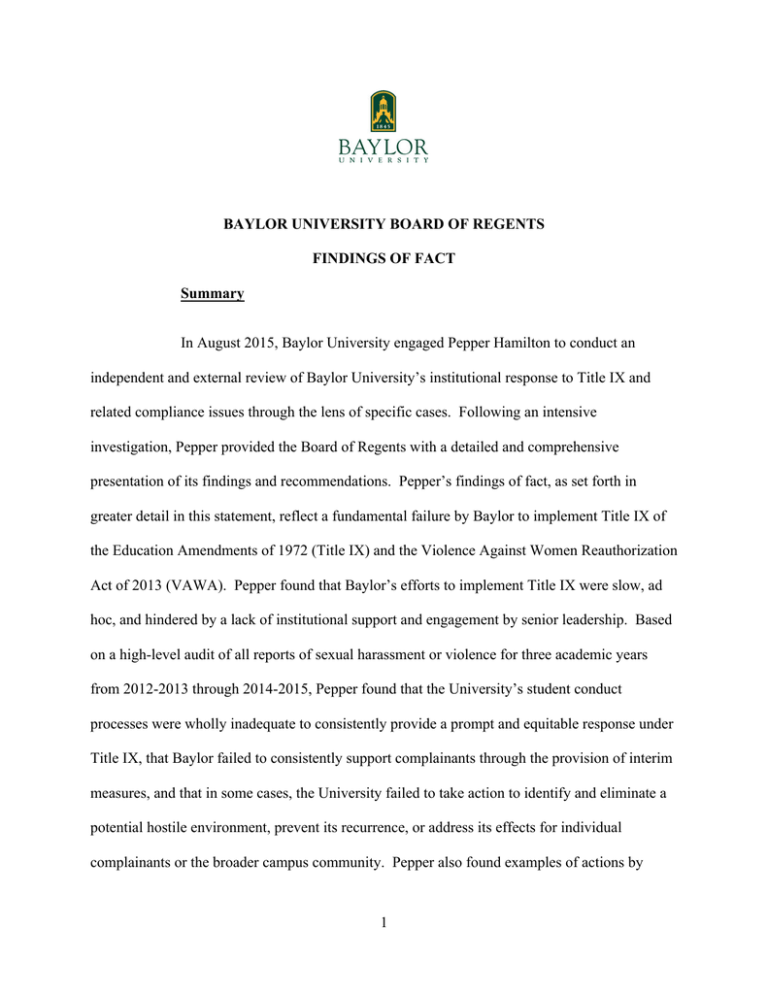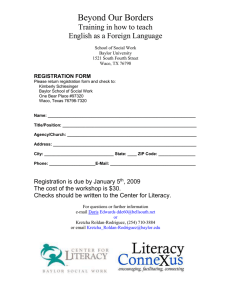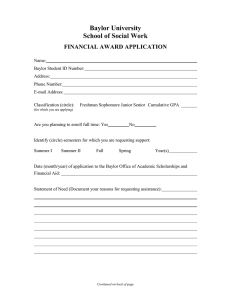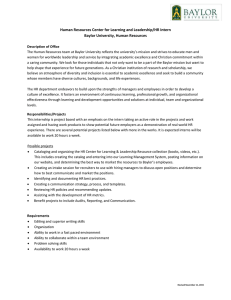
BAYLOR UNIVERSITY BOARD OF REGENTS
FINDINGS OF FACT
Summary
In August 2015, Baylor University engaged Pepper Hamilton to conduct an
independent and external review of Baylor University’s institutional response to Title IX and
related compliance issues through the lens of specific cases. Following an intensive
investigation, Pepper provided the Board of Regents with a detailed and comprehensive
presentation of its findings and recommendations. Pepper’s findings of fact, as set forth in
greater detail in this statement, reflect a fundamental failure by Baylor to implement Title IX of
the Education Amendments of 1972 (Title IX) and the Violence Against Women Reauthorization
Act of 2013 (VAWA). Pepper found that Baylor’s efforts to implement Title IX were slow, ad
hoc, and hindered by a lack of institutional support and engagement by senior leadership. Based
on a high-level audit of all reports of sexual harassment or violence for three academic years
from 2012-2013 through 2014-2015, Pepper found that the University’s student conduct
processes were wholly inadequate to consistently provide a prompt and equitable response under
Title IX, that Baylor failed to consistently support complainants through the provision of interim
measures, and that in some cases, the University failed to take action to identify and eliminate a
potential hostile environment, prevent its recurrence, or address its effects for individual
complainants or the broader campus community. Pepper also found examples of actions by
1
University administrators that directly discouraged complainants from reporting or participating
in student conduct processes, or that contributed to or accommodated a hostile environment. In
one instance, those actions constituted retaliation against a complainant for reporting sexual
assault. In addition to broader University failings, Pepper found specific failings within both the
football program and Athletics Department leadership, including a failure to identify and respond
to a pattern of sexual violence by a football player, to take action in response to reports of a
sexual assault by multiple football players, and to take action in response to a report of dating
violence. Pepper’s findings also reflect significant concerns about the tone and culture within
Baylor’s football program as it relates to accountability for all forms of athlete misconduct.
Overview of Engagement
In August 2015, Baylor University engaged Pepper Hamilton LLP (Pepper) to
conduct an independent and external review of Baylor University’s institutional response to Title
IX and related compliance issues through the lens of specific cases. A Special Committee of the
Board of Regents, on behalf of the University, accepted the President and Chancellor’s
recommendation to engage Pepper in order to ensure objectivity, and Pepper was provided with
unfettered access to personnel and data. Pepper’s review was detailed, thorough and rigorous.
While keeping within the scope of the engagement, Pepper engaged in an open exploration of the
issues with no limitation by the University. Pepper conducted document-based interviews to
ensure accuracy, integrity and efficiency, and Pepper’s findings and recommendations are based
on the law, related authority, facts and reasonable inferences from the facts.
Pepper reviewed emails, mobile device data, and documents from current and
former Baylor employees. Pepper’s review of documents included current and prior policies and
2
procedures, Judicial Affairs and Title IX files related to specific reports and investigations,
relevant trial transcripts, personnel files, student records, training and educational materials, prior
internal and external audits, Title IX Task Force materials, and other relevant and available
information. In addition to an exhaustive review of data, Pepper interviewed more than 65
individuals, including current employees, former employees, current students, and former
students. The current and former students included individuals who identified as
victims/survivors of sexual assault or dating violence. Pepper interviewed witnesses across
multiple departments, including the President’s Office, Executive Council, Student Life, Judicial
Affairs (now called Student Conduct Administration), the Office of General Counsel, the
Athletics Department, the football program, Athletics Compliance, Risk Management, Human
Resources, the Counseling Center, Health Services, Baylor University Police Department, the
Title IX Office, Faculty Athletic Representatives, the Admissions Office and outside counsel.
Many individuals were interviewed more than once to allow for a full and fair opportunity to
reconcile and synthesize information in the context of documents and available information from
other interviews.
Over the course of the engagement, Pepper provided the Special Committee with
detailed and specific information and regular updates. Earlier this month, Pepper provided the
full Board of Regents with a detailed and comprehensive presentation outlining Pepper’s
findings of fact and recommendations. This statement contains the salient findings, which are
being shared publicly to reflect transparency and accountability. The findings discussed below
occurred in one or more of the cases reviewed. This statement also contains Pepper’s
recommendations, which have been adopted by the Board.
3
Failure to Prioritize, Recognize, Implement and Resource Title IX
Baylor failed to effectively implement Title IX in the wake of the U.S.
Department of Education’s Office for Civil Rights (OCR) April 4, 2011 “Dear Colleague
Letter,” the passage of the Violence Against Women Reauthorization Act of 2013 (VAWA), and
related authority and guidance. While individual administrators identified emerging and
evolving Title IX and VAWA requirements, the University as a whole failed to prioritize Title
IX implementation. Implementation efforts were slow, ad hoc, diffuse, and uncoordinated.
Senior leadership failed to recognize the significance of the national context, including evolving
guidance from OCR and high profile examples of institutional failures at peer institutions. As a
result, Baylor lacked the sufficient infrastructure and an informed policy. The administration
instead relied upon existing personnel until November 2014, and existing processes (the Student
Code of Conduct and Civil Rights Policy) until August 2015, when Baylor’s Sex Discrimination,
Sexual Violence, and Sexual Harassment Policy was adopted. The administrators tasked with
implementing Title IX prior to November of 2014 had a limited understanding of the dynamics
of sexual violence and existing barriers to reporting on Baylor’s campus, including the impact of
other campus policies regarding the prohibition of alcohol and extra-marital sexual intercourse.
The insufficient dedication of resources and support to the University’s Title IX function led to
limited visibility of Title IX on campus.
Baylor’s institutional response failed to integrate Title IX and VAWA
requirements. Prior to the 2014-2015 academic year, Baylor failed to provide training and
education to students; failed to identify and train responsible employees under Title IX; failed to
provide clear information about reporting options and resources on campus; failed to have a
centralized process for ensuring that all reports reached the Title IX Coordinator; failed to
4
impose appropriate interim measures in many cases; failed to appropriately evaluate and balance
institutional safety and Title IX obligations against a complainant’s request for anonymity or that
no action/investigation be pursued against; failed to conduct prompt, equitable, adequate, and
reliable investigations; failed to give complainants access to full range of procedural options
under the policy; and failed to take sufficient action to identify, eliminate, prevent and address a
potential hostile environment in individual cases. Institutional failures at every level of Baylor’s
administration directly impacted the response to individual cases and the Baylor community as a
whole.
Many Factors Impeded Effective Implementation of Title IX
Baylor’s senior leadership lacked consistent or meaningful engagement in the
University’s Title IX functions. The composition and functioning of the Executive Council did
not provide effective leadership for integration of Title IX compliance responsibilities across all
University functions. The University lacked a proactive compliance function that would have
identified the nature of the risks attendant to sexual and gender-based harassment and violence
and interpersonal violence, the likelihood of occurrence, and the adequacy of existing controls to
ensure an informed and effective institutional response. In addition to their many other
responsibilities, administrators assumed elements of the Title IX function on an ad hoc basis,
which impeded timely implementation of rapidly evolving Title IX and VAWA mandates. The
University did not maintain systems or protocols to coordinate information or keep centralized
records necessary to fulfill compliance mandates, and the University did not carefully review
roles and responsibilities of Title IX implementers to assure that there was no actual or perceived
conflict within the assigned multiple roles held by many Title IX administrators.
5
The University did not provide sufficient institutional support for Title IX
functions. Prior to November 2014, the Title IX Coordinator position was assigned to senior
administrators, each of whom already had a full profile of professional responsibilities. The
administrators in those roles lacked the necessary training, experience and frame of reference to
meaningfully implement Title IX responsibilities. They also lacked the necessary time,
resources or infrastructure to meaningfully implement Title IX responsibilities. Moreover, when
the University hired a full-time Title IX Coordinator in November 2014, the University
underestimated the level of infrastructure and resources that would be necessary for successful
implementation. The Title IX Coordinator did not have sufficient institutional support from
senior leadership, or experienced and trained supervision, necessary to promote timely and
effective implementation. Despite the hiring of two full-time investigators, Baylor’s Title IX
Coordinator did not have sufficient or qualified support within the Title IX Office. Because of
the overwhelming need for education and training, the Title IX Coordinator and staff did not
have sufficient time or resources to focus on building the infrastructure of the office, drafting
internal operating procedures and template communications, or managing the influx of new
reports. In addition, as of the spring of 2015, there were no clear protocols for documentation or
consistency in practice across implementers.
Inadequate Institutional Response to Sexual Violence under Title IX/VAWA
A high-level audit was conducted of all known reports of sexual harassment and
sexual assault reported through Baylor’s student conduct processes for three academic years:
2012-2013, 2013-2014, and 2014-2015. The overwhelming majority of cases did not move
forward to an adjudicative hearing, with only an extremely limited number of cases resulting in a
finding of responsibility or significant sanction. Many complainants did not move forward with
6
the University’s Title IX process, and the University failed to appropriately weigh a request not
to move forward against the University’s Title IX obligation to investigate or otherwise
determine what occurred. The University failed to conduct sufficient inquiry into individual
barriers to participation, which in some instances were directly related to barriers created by
conversations with University personnel that discouraged, rather than encouraged, participation
in the University’s Title IX processes. Even in those cases where a complainant did choose to
move forward, Baylor did not pursue hearings in the majority of reports, sometimes because of
an erroneous determination that Baylor did not have jurisdiction in off campus matters or
because the investigator in Judicial Affairs improperly determined that there was not a
preponderance of the evidence based on an inadequate or uninformed investigation. As a
consequence, in some cases, the University failed to take action to identify and, as needed,
eliminate a potential hostile environment, prevent its recurrence, or address any effects on the
individual complainant or broader campus community.
With respect to sexual assault investigations conducted by Judicial Affairs, staff
members in Judicial Affairs applied a very “by the book” student conduct approach that treated
all respondents equally, regardless of their status as a student-athlete. However, this rigid
approach was not trauma-informed and was overly reliant on the perceived consistency or
inconsistency of complainant’s statements to the exclusion of other relevant considerations. The
investigations reviewed were wholly inadequate to fairly and reliably evaluate whether sexual
violence had occurred. While individual administrators sought professional training
opportunities, they were not adequately trained in the dynamics of sexual and gender-based
harassment and violence, dating violence, domestic violence, stalking, the neurobiological
impacts of trauma, the evaluation of credibility, consent and the role of alcohol as it relates to
7
consent and alcohol-facilitated sexual assault. In addition, the investigations were conducted in
the context of a broader culture and belief by many administrators that sexual violence “doesn’t
happen here.” Administrators engaged in conduct that could be perceived as victim-blaming,
focusing on the complainant’s choices and actions, rather than robustly investigating the
allegations, including the actions of the respondent. In many instances, student conduct
investigators conducted cursory investigations and failed to identify and interview readily
apparent witnesses or gather relevant evidence. Student conduct investigators also applied the
preponderance of the evidence standard of proof in an inconsistent manner, and in many
instances, required a far greater level of proof than preponderance.
Prior to the 2014-2015 academic year, Baylor failed to conduct adequate training
and education for its students and employees, and Baylor had not created an atmosphere that
fostered reporting and participation in the Title IX process. Baylor’s students lacked awareness
of the range of conduct prohibited under Title IX and of University policies, resources or
reporting options. A lack of clearly identified reporting mechanisms, combined with insufficient
training and attention to sexual and gender-based harassment and violence and other forms of
interpersonal violence, may have led to significant underreporting by students and missed
opportunities by administrators to respond appropriately to reports. The University’s approach
to issues related to alcohol or other drug use by students created barriers to reporting. In
addition, prior to August 2015, the University did not have a written amnesty policy for alcohol
or other drug violations when reporting misconduct. Perceived judgmental responses by
administrators based on a complainant’s alcohol or other drug use or prior consensual sexual
activity also discouraged reporting or continued participation in the process.
8
Prior to the creation of the Title IX office in November 2014, once reports were
received, Baylor failed to consistently identify or impose appropriate interim protective
measures. In many instances, Baylor’s responses to the needs of individual complainants were
uncoordinated and ad hoc, and complainants received inconsistent and inadequate support. In
some instances, the burden was placed on complainants to identify and obtain appropriate
interim measures. Administrators failed to exercise appropriate oversight of interim measures,
think holistically about the needs of complainants, follow through and follow up with
complainants, provide complainants with continued access to educational opportunities, and take
sufficient steps to retain complainants as University students.
Baylor did not have a system or protocol for either the consistent coordination of
information between and among implementers, or for consistent, centralized sharing of
information and documentation that would have allowed the University to track, identify,
investigate or address a pattern of sexual violence at the earliest opportunity. Once aware of a
potential pattern of sexual violence, the University failed to take prompt and effective action to
protect campus safety and protect future victims from harm. Further, Baylor failed to consider
patterns, trends or climate-related concerns that would enable the University to take prompt and
responsive action to individual and community concerns. Baylor failed to identify, eliminate,
prevent or address a potential hostile environment in individual cases, and took insufficient steps
with respect to both individual complainants and broader community remedies.
In some instances, administrative responses and campus processes caused
significant harm to complainants. Actions by an University administrator within BUPD and an
administrator within an academic program contributed to, and in some instances, accommodated
or created a hostile environment, rather than taking action to eliminate a hostile environment.
9
Barriers to Implementation of Title IX within Baylor’s Football Program
Baylor failed to maintain effective oversight and supervision of the Athletics
Department as it related to the effective implementation of Title IX. Leadership challenges and
communications issues hindered enforcement of rules and policies, and created a cultural
perception that football was above the rules. In addition to the issues related to student
misconduct, the University and Athletics Department failed to take effective action in response
to allegations involving misconduct by football staff. Further, despite the fact that other
departments repeatedly raised concerns that the Athletics Department’s response to student or
employee misconduct was inadequate, Baylor administrators took insufficient steps to address
the concerns.
Baylor failed to take appropriate action to respond to reports of sexual assault and
dating violence reportedly committed by football players. The choices made by football staff
and athletics leadership, in some instances, posed a risk to campus safety and the integrity of the
University. In certain instances, including reports of a sexual assault by multiple football
players, athletics and football personnel affirmatively chose not to report sexual violence and
dating violence to an appropriate administrator outside of athletics. In those instances, football
coaches or staff met directly with a complainant and/or a parent of a complainant and did not
report the misconduct. As a result, no action was taken to support complainants, fairly and
impartially evaluate the conduct under Title IX, address identified cultural concerns within the
football program, or protect campus safety once aware of a potential pattern of sexual violence
by multiple football players.
10
In addition, some football coaches and staff took improper steps in response to
disclosures of sexual assault or dating violence that precluded the University from fulfilling its
legal obligations. Football staff conducted their own untrained internal inquiries, outside of
policy, which improperly discredited complainants and denied them the right to a fair, impartial
and informed investigation, interim measures or processes promised under University policy. In
some cases, internal steps gave the illusion of responsiveness to complainants but failed to
provide a meaningful institutional response under Title IX. Further, because reports were not
shared outside of athletics, the University missed critical opportunities to impose appropriate
disciplinary action that would have removed offenders from campus and possibly precluded
future acts of sexual violence against Baylor students. In some instances, the football program
dismissed players for unspecified team violations and assisted them in transferring to other
schools. As a result, some football coaches and staff abdicated responsibilities under Title IX
and Clery; to student welfare; to the health and safety of complainants; and to Baylor’s
institutional values.
In addition to the failures related to sexual assault and dating violence, individuals
within the football program actively sought to maintain internal control over discipline for other
forms of misconduct. Athletics personnel failed to recognize the conflict of interest in roles and
risk to campus safety by insulating athletes from student conduct processes. Football coaches
and staff took affirmative steps to maintain internal control over discipline of players and to
actively divert cases from the student conduct or criminal processes. In some cases, football
coaches and staff had inappropriate involvement in disciplinary and criminal matters or engaged
in improper conduct that reinforced an overall perception that football was above the rules, and
that there was no culture of accountability for misconduct.
11
The football program also operates an internal system of discipline, separate from
University processes, which is fundamentally inconsistent with the mindset required for effective
Title IX implementation, and has resulted in a lack of parity vis-à-vis the broader student
population. This informal system of discipline involves multiple coaches and administrators,
relies heavily upon individual judgment in lieu of clear standards for discipline, and has resulted
in conduct being ignored or players being dismissed from the team based on an informal and
subjective process. The ad hoc internal system of discipline lacks protocols for consistency with
University policy and is wholly undocumented. The football program’s separate system of
internal discipline reinforces the perception that rules applicable to other students are not
applicable to football players, improperly insulates football players from appropriate disciplinary
consequences, and puts students, the program, and the institution at risk of future misconduct. It
is also inconsistent with institutional reporting obligations.
The football program failed to identify and maintain controls over known risks,
and unreasonably accepted known risks. Leadership in football and the athletics department did
not set the tone, establish a policy or practice for reporting and documenting significant
misconduct. The lack of reporting expectations resulted in a lack of accountability for player
misconduct and employee misconduct. Further, no attempt was made to understand the root
causes of behavior or steps necessary to prevent its recurrence. In addition, in one instance, in
response to concerns about misconduct by football players that could contribute to a hostile
environment, an academic program that required interaction with the football program
improperly restricted educational opportunities for students, rather than take steps to eliminate a
potential hostile environment.
12
Failure to Implement or Follow Consistent Transfer Protocols
Baylor did not consistently conduct due diligence with respect to potential
transfers. In at least one identified instance, the process reflected a failure to conduct appropriate
due diligence and assessment of risk regarding past criminal or student conduct and an
affirmative decision not to seek additional information about an athlete’s prior criminal or
student conduct records. Baylor did not adhere to a consistent protocol regarding transfers and
importantly, Baylor did not consistently follow previously implemented processes regarding
criminal background checks, request for records of any prior college disciplinary actions, and
character reference screening forms.
Conclusion
The University has taken and will take additional steps to address the deficiencies
noted in the findings of fact. The Board has already adopted Pepper’s recommendations, which
are set forth in a separate document.
13



